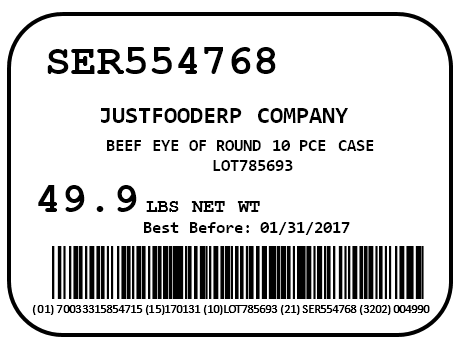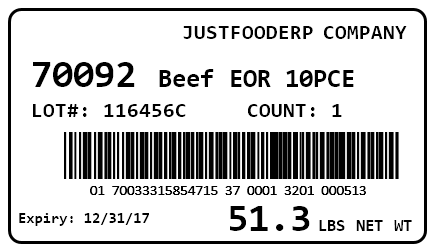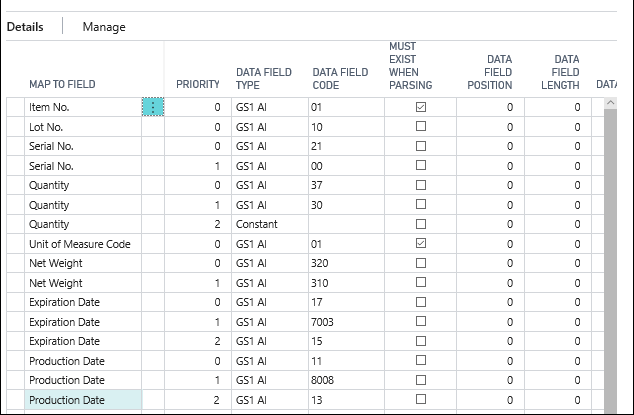Walkthrough: Work with Vendor GS1 Bar Codes
This walkthrough demonstrates how to perform the following tasks:
Set up vendor GS1 Bar Codes.
Set up Floor to use GS1 Bar Codes.
How to receive in Floor using GS1 Bar Codes
View scanned Bar Code entries.
Function Background
A GS1 Bar Code includes different data about a product. Often, below the Bar Code is information that you can read.
Note
The information that you can read does not represent what is actually embedded inside the Bar Code.
GS1 Bar Codes include a standard set of application identifiers, which identify the meaning and formatting of the data within the Bar Code. For example, (17) is the expiry date in the YYMMDD format. GS1 Bar Codes also include the Global Trade Item Number (GTIN), which uniquely identifies the item and the item's Unit of Measure (UOM). The GTIN is (01) and is always a fixed length of 14 numbers. For more information about GS1 Bar Codes, visit www.GS1.org.

When scanning, the Bar Code is read as ]C1019323044312434010103379GS171610252141132322GS3201000217371. ]C1.
]C1 is a function code that tells the scanner that the Bar Code is a GS1.
GS is a group separator, which is used to identify the end of variable length data. For example, 10 is the lot number, which can be any length. The group separator indicates the end of the lot number. This is different from the expiry date 17, which is always six characters and therefore does not require a separator.
When scanning the Bar Code, the scanner cannot read the group separator, so the scanner must be configured so that the scanner converts the group separator to a readable character. For example, on your scanner, you can set up the scanner so that the scanner interprets the separator as an equals sign (=), which means the Bar Code is read as ]C1019323044312434010103379=171610252141132322=3201000217371.
When the Bar Code is scanned, the information is sent to JustFood and the information is deciphered as follows:
]C1: Recognizes that this is a valid GS1 Bar Code.
0193230443124340: 01=GTIN. Parses the next 14 characters, and verifies they are a valid GTIN.
10103379=: 10=Lot Number. This is variable length data, and parses the data to the global separator.
17161025: 17=Expiry Date. Parses the next 6 characters as YYMMDD.
2141132322=: 21=Serial Number: This is variable length data, and parses the data to the global separator.
3201000217: 3201=Weight in Pounds with 1 Decimal. Parses the next 6 characters as pounds, and applies the appropriate decimal place, in this case 1 decimal place.
371: 37=Quantity. Parses the next 8 characters, no decimals allowed, and assumes the UOM of the GTIN.
As a result, the following information is pulled from the scanned Bar Code:
GTIN: 93230443124340
Lot Number: 103379
Expiry: 10/25/2016
Serial Number: 41132322
Weight (LBS): 21.7
Quantity: 1
Story
The JF Company purchases the BEEF EYE OF ROUND 10PC (FAM-RAW-00002) item from two different vendors, and each of those vendors creates their own GS1-128 Bar Code.
The GTINs for the item are as follows:
Case: 70033315854715
Pack (contains 4 cases): 70033315854722
Pallet (contains 12 cases): 70033315854739
The Olympic Wholesale vendor's Bar Code includes the following information:

| Name | Application Identifier |
|---|---|
| GTIN | 01 |
| Best Before | 15 |
| Lot number | 10 |
| Serial number | 21 |
| Net weight in pounds where n represents the number of decimal places | 320n |
The Ashley Costa vendor's Bar Code includes the following information:

| Name | Application Identifier |
|---|---|
| GTIN | 01 |
| Quantity | 37 |
| Net weight in pounds where n represents the number of decimal places | 320n |
Prerequisites
You know the GTIN of the items that you purchase.
A scanner has been set up so that the scanner inserts separators when scanning.
Set Up Vendor GS1 Bar Codes
To set up vendor GS1 Bar Codes, you must complete the following tasks:
Set Up GS1 Weights
Set Up GS1 Separators
Set Up a Vendor GS1 Bar Code Type
Set Up the GTIN Cross References
Test Parse a Bar Code
Set Up the GS1 Weights
On the Units of Measure page, you must set up a specific weight type, which allows GS1 weight parsing to identify which UOMs are pounds and kilograms.
To set up the GS1 weights
Choose
 , enter units of measure, and then choose the related link.
, enter units of measure, and then choose the related link.The Units of Measure page opens.
On the action bar, choose Edit List.
For the unit of measure that represents kilograms, in the Specific Weight Type field, select Kilogram.
For the unit of measure that represents pounds, in the Specific Weight Type field, select Pounds.
Set Up GS1 Separators
You must define the character that will be used to separate the Bar Code data fields.
Important
You must set up your scanner so that the scanner inserts a separator when scanning.
To set up GS1 separators
Choose
 , enter bar code setup, and then choose the related link.
, enter bar code setup, and then choose the related link.The Bar Code Setup page opens.
In the GS1 Separator Character (Unicode) field, enter the unicode that represents the separator that was defined on the scanner. For example, 61 is the unicode for the equals sign (=).
Note
Do not set the separator to a character that might be found in the Bar Code.
Set Up a Vendor GS1 Bar Code Type
The vendors that the JF Company buys from, all use different configurations of GS1-128 Bar Codes, which use Application Identifiers (AIs) to identify the different information in the Bar Code.
A GS1 Bar Code type must be set up that represents the AIs that are contained in the different GS1 vendor Bar Codes.
To set up a vendor GS1 Bar Code Type
Choose
 , enter bar code types, and then choose the related link.
, enter bar code types, and then choose the related link.The Bar Code Types page opens.
On the action bar, choose New.
The Bar Code Type Code Card page opens.
On the General FastTab, perform the following steps:
In the Code field, enter a code to represent the vendor Bar Code.
In the Description field, enter a description of the vendor Bar Code.
In the Type field, select GS1-128.
Turn on Default.
When Default is turned on, the GS1 Bar Code type will be printed on the Inventory Label report.
Turn on Allow Parsing.
When Allow Parsing is turned on, the Bar Code type is considered when trying to match a scanned Bar Code with a Bar Code Type Code.
In the Parse Order field, ensure that 0 is entered.
The Parsing FastTab includes the information that allows JustFood to determine whether an incoming scanned Bar Code matches a Bar Code type. On the Parsing FastTab, perform the following steps:
Turn on First Two Chars are Numeric.
Turn on First Two Chars are Valid AI.
Turn on First Data Segment is Valid AI.
Set up the Details section as shown in the screen capture below:

The values in the Data Field Code fields represent the AIs for the GS1 Bar Code.
You can map a field to more than one Data Field Code. For example, Serial No. is mapped to 21 (serial number) and to 00 (Serial Shipping Container Code), which means if a Bar Code has 21 or 00 as an application identifier, the information will be mapped to the serial number.
The Unit of Measure line has the same data field code as the Item No. line because the UOM is based on the GTIN. The GTIN and the GTIN's UOM must be cross referenced with an item.
The Quantity record where the Data Field Type is Constant inserts a quantity of 1 when an AI did not exist for the other two quantities.
Set up the GTIN Cross References
For JustFood to recognize a GTIN, you must cross reference the GTIN with an item in JustFood. GTINs are based on an item's UOM so you also must specify the UOM for each GTIN.
The GTINs for the item are as follows:
Case: 70033315854715
Pack (includes 4 cases): 70033315854722
Pallet (includes 12 cases): 70033315854739
To set up the GTIN cross references
Choose
 , enter items, and then choose the related link.
, enter items, and then choose the related link.The Items page opens.
Select an item that you purchase from a vendor, and then on the action bar, choose Manage > View. In this case, BEEF EYE OF ROUND 10PC (FAM-RAW-00002).
The Item Card page opens.
On the action bar, choose Navigate > Item > Cross References.
Add the following lines that appear in the following table:
Cross-Reference Type Cross-Reference No. Bar Code Type Code Unit of Measure Bar Code 70033315854715 VENDOR_GS1_ALL CASE Bar Code 70033315854722 VENDOR_GS1_ALL PACK Bar Code 70033315854739 VENDOR_GS1_ALL PLT Note
You must enter a valid GTIN, otherwise, the Bar Code cannot be scanned correctly.
Test Parse the Bar Codes
You can check that you have set up your vendor Bar Codes correctly by test parsing the Bar Code. This action will check the Bar Code, and if successful, will list the data found within the Bar Code.
When test parsing the Bar Code, you must enter the Bar Code in the way that the scanner will read it. As a result, you must remove unnecessary characters and spaces, and you must add a separator, as defined on the Bar Codes Setup page, between data fields.
For example, a readable vendor Bar Code number is displayed as (01) 70033315854715 (15)170131 (10)LOT785693 (21) SER554768 (3202) 004990, but when test parsing the data, you must remove the parentheses and spaces, and you must insert separators between the data fields so that the code looks like 0170033315854715=15170131=10LOT785693=21SER554768=3202004990.
Note
You do not have to insert a separator after a fixed length value, but if you do not know which values are fixed and which are variable, you can enter a separator between all the data fields.
To test parse the Bar Codes
Choose
 , enter test parse bar code, and then choose the related link.
, enter test parse bar code, and then choose the related link.The Test Parse Bar Code page opens.
In the Bar Code field, enter the Bar Code.
The Details section is populated when the Bar Code is recognized.
Set Up Floor to use GS1 Bar Codes
Only the Guided screens in Floor can interpret the data in a GS1 Bar Code. You must set up JustFood so that Floor will use these Guided screens. For more information, see Set up Floor Guided Interfaces.
Receiving in Floor using GS1 Bar Codes
You have purchased the BEEF EYE OF ROUND 10PC (FAM-RAW-00002) item from the Olympic Wholesale and Ashley Costa vendors that use GS1 Bar Codes.
The items have arrived at the warehouse, and you are ready to scan the items using your scanner that is set up with Floor.
When a vendor label has an application identifier of 00 (container data) or 21 (serial number), and the Bar Code has not been used previously during receiving, you can keep the vendor label. The Bar Codes from the Olympic Wholesale vendor include enough information so you will not be required to print a new label. But the Bar Codes from the Ashley Costa vendor do not include enough information, and you will be required to print new labels.
Scan a Vendor Label while Receiving and Keep the Label
The Olympic Wholesale Bar Code includes the application identifier 21, which represents the serial number, therefore you can keep the vendor label.

To scan a vendor label while receiving and keep the label
Open Floor.
From the Main Menu, choose Receiving.
To view the list of warehouse receipts, choose Whse. Receiving, and then choose Search.
Select the warehouse receipt, and then choose Open.
The Warehouse Receipt Lines page opens.
Select the line that you want to receive.
The Guided Whse. Receipt Entry page opens.
At the Bar Code field, scan the vendor Bar Code.
Floor reads the data in the Bar Code. If any required information is missing, you are prompted to enter that information.
If prompted, enter any required information that is not included in the scanned Bar Code, and then to advance to the next field, choose Enter.
If all the items on the line have been entered, the field stays on the last input field.
If more items must be entered for the line, you are returned to the Bar Code field.
If there are more lines to receive, move to the next line.
When all of the items have been received, to post the entire receipt, on the Whse. Receipt Entry page, choose Post.
Scan a Vendor Label while Receiving and Print a New Label
The Ashley Costa Bar Code does not contain a 00 or 21 application identifier, which means a new label must be printed.

To scan a vendor label while receiving and print a new label
Open the Floor application.
On the Main Menu, choose Receiving.
To view the list of warehouse receipts, choose Whse. Receiving, and then choose Search.
Select the warehouse receipt, and then choose Open.
The Warehouse Receipt Lines page opens.
Select the line that you want to receive.
The Guided Whse. Receipt Entry page opens.
At the Bar Code field, scan the vendor Bar Code.
Floor reads the data in the Bar Code. If any required information is missing, you will be prompted to enter that information.
Because the bar code does not have an application identifier of (00) or (21), you will see a message that says Re-Labeling Required.
If prompted, enter any required information that is not included in the scanned Bar Code, and then to advance to the next field, choose Enter.
After you have entered information in the last field, when you choose Enter, you are automatically taken to the Print page.
Note
The displayed label is not the exact label that will be printed.
Choose Print.
The label prints.
If all the items on the line have been entered, you are returned to the last input field.
If more items must be entered for the line, you are returned to the Bar Code field.
If there are more lines to receive, move to the next line.
When all of the items have been received, to post the entire receipt, on the Whse. Receipt Entry page, choose Post.
View the Scanned Bar Code Entries
After a vendor Bar Code is scanned, you can view the information that is associated with the Bar Code. This information will be used the next time the Bar Code is scanned.
To view the scanned Bar Code entries, choose  , enter bar code tracking entries, and then choose the related link.
, enter bar code tracking entries, and then choose the related link.
The Bar Code Tracking Entries page opens.
The Bar Code field is only populated if the Bar Code is unique, that is, the Bar Code includes an application identifier of 00 (container ID) or 21 (serial number).